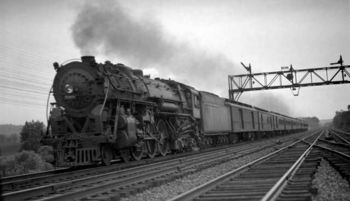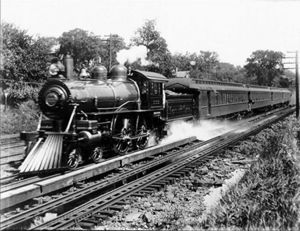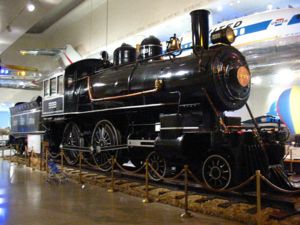Empire State Express


The Empire State Express was one of the named passenger trains and onetime flagship of the New York Central and Hudson River Railroad (a predecessor of the modern New York Central Railroad). It became the world's first high-speed passenger train on September 14, 1891, when it covered the 436 miles (702 kilometers) between New York City and Buffalo in just 7 hours and 6 minutes (including stops). The train averaged 61.4 miles-per-hour (98.8 km/h), a new world speed record in rail travel, with an officially-recorded top speed of 82 mph (132 km/h), though observers claimed to have clocked the train at 112 mph, or 180 km/h.[1]
In short order, the train would gain worldwide celebrity, and its route would stretch to almost 1,000 miles (1,600 km), with Chicago, Illinois as its western terminus. In addition to its other notable accomplishments, the Empire State was the first passenger train to maintain a regular schedule speed of over 52 mph (84 km/h), and the first to make runs of 142.88 miles (230 km) between stops (between New York City and Albany, the longest scheduled nonstop run ever attempted).
When Amtrak took over operation of the nation's passenger service on May 1, 1971 it thereby ended the 90-year run of the Empire State Express on the New York Central, though Amtrak would continue to use the name for many years to come. Today, a portion of the route is covered by Amtrak's Empire Service.
Contents
Empire State Express No. 999

The key to the Empire State's initial fame was a specially-outfitted, 37-foot-long American-type 4-4-0 steam locomotive that was built especially to haul the train. The handmade unit was mounted on 86" diameter driving wheels, and was the first of its kind to have brakes mounted to the front truck. The bands, pipes, and trim were highly polished; the boiler, smokestack, domes, cab, and tender were given a black satin finish, and "Empire State Express" was applied to the sides of the tender in 2'-6" high gold leaf lettering.
No. 999 entered service in May of 1893, making the trip from Syracuse, New York to the Chicago World's Fair. The Express was recorded traveling at 121.5 mph (195.5 km/h) by unofficial timers during an exhibition run between Batavia and Buffalo on May 10, making No. 999 the fastest-moving manmade invention of its time and the first object on wheels to exceed 100 mph (161 km/h).[1] Over 3,000 22" gauge scale replicas (most likely made by the Cagney Brothers and known as therefore "Cagneys") were sold at $1,500 each and shipped to amusement parks as far away as South Africa and Thailand; one such unit, nicknamed the "Little Puffer" is in service today at the Fleischaker Zoo in San Francisco, California. Manufacturers of electric train sets began putting No. 999 on their locomotives.
Advances in locomotive design, particularly the advent of diesel-electric power, eventually rendered No. 999 obsolete. After touring the nation and making appearances at numerous expositions including the Chicago Railroad Fair, the unit (regarded by many as the world's most beautiful locomotive ever built) was retired from service in May, 1952 at which time it was relegated to yard switching service in western New York shuttling express service milk cars. The New York Central donated the locomotive to the Chicago Museum of Science and Industry in 1962, where it has been preserved and placed on static display. The unit as displayed lacks its original 86" drivers, which were removed sometime after the historic speed run with smaller diameter drive wheels. [2]
Equipment used
An early (circa 1905) heavyweight consist:
Note: The Vice President's private car was often attached to the end of the train for special excursions.
In song and on film
In 1896, the Empire State Express was the subject of a short documentary film, which was described by the critics of the day as "The greatest train view ever taken."
In 1965, blues singer and guitarist Eddie James "Son" House, Jr., at the time a New York Central employee, recorded "Empire State Express" at the New York Folk Festival:
- Went down to the station,
- Leaned against the door.
- Went down to the station,
- I...leaned against the door.
- I knew it was the Empire State,
- Can tell by the way she blows.
- Asked the depot agent,
- "Please let me ride the blinds."
- Asked the depot agent,
- "Please let me ride the blinds."
- He said, "Son, I like to help you...you know,
- But the Empire State ain't mine".
- The Empire State...you know she,
- Rides on Eastern time.
- The Empire State,
- She rides on Eastern time,
- She's the "rollingest" baby,
- On the New York Central line.
- excerpt from "Empire State Express" by Son House
No. 999 was the inspiration for the eponynous steam engined-shaped space vehicle in the Galaxy Express 999 series of manga and animated films.
References
- Empire State Express No. 999. Genesee County, New York. Retrieved on March 1, 2006.
- Hollingsworth, Brian and Arthur F. Cook (1987). The Great Book of Trains. Portland House, New York, NY. ISBN 0-517-64515-7.
- The Two Fastest Long Distance Runs Without Stop. Scientific American — September 3, 1898. Retrieved on March 1, 2006.
- Yenne, Bill (1992). The Great Railroads of North America. Brompton Books Corporation, Greenwich, CT. 0-88029-783-2.
- ↑ 1.0 1.1 John Lienhard. Rain, Steam & Speed: Inventing Powered Motion. Retrieved on 2007-01-28.
- ↑ John Lienhard. Rain, Steam & Speed: Inventing Powered Motion. Retrieved on 2007-01-28.
See also
External links
- New York Central Sleeping and Parlor Car Equipment and Assignment of Space for the Empire State Express, Part I.
- New York Central Sleeping and Parlor Car Equipment and Assignment of Space for the Empire State Express, Part II.
- Empire State Express at the Internet Movie Database.
- The Empire State Express & Webb C. Ball contains various vintage images and trivia.

